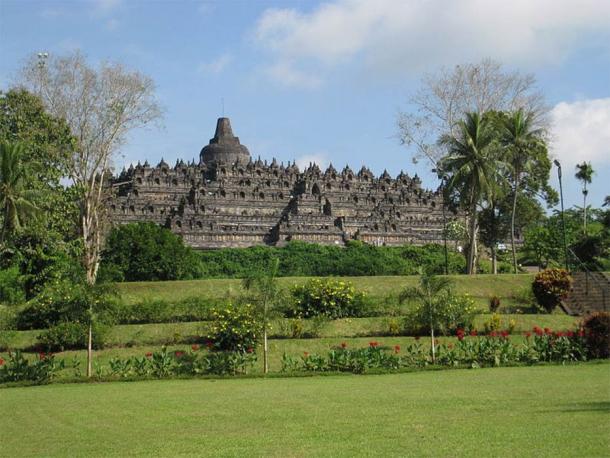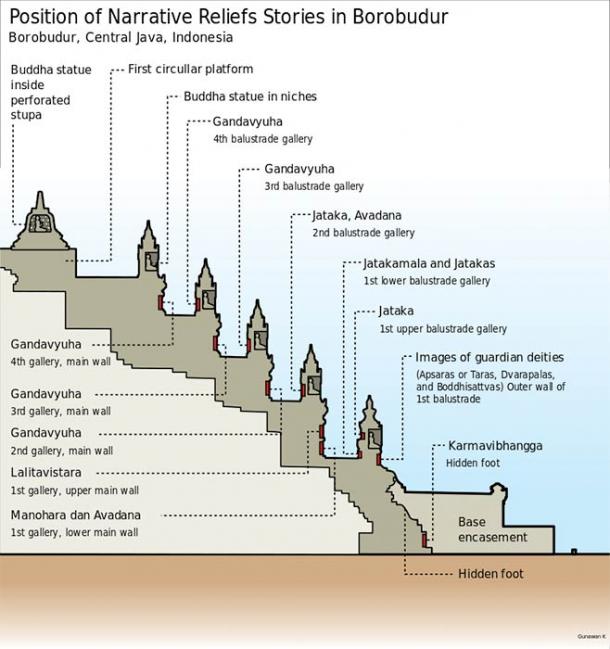The Borobudur Temple , the massive Mahayana Buddhist temple in Central Java, Indonesia, was built in the ninth century during the reign of the Shailendra Dynasty, which emerged in eighth-century Java. The temple’s design combines the Buddhist concept of attaining Nirvana, the release from karma and the cycle of death and rebirth, with traces of the Gupta art reflecting the influence of ancient India on the region. Apart from being a shrine to the Lord Buddha, Borobudur is also a temple for Buddhist pilgrimage. A pilgrim’s journey begins at the base of the monument and follows a path around the temple. The pilgrim then ascends to the top of the monument through the three realms in the Buddhist cosmology. Those three realms are Kamadhatu (“the world of desire”), Rupadhatu (“the world of forms”) and Arupadhatu (“the world of formlessness”). However, to experience this journey, the pilgrim will first walk through the gate of the temple adorned with a terrifying head which gives the illusion of the gate looking like the open mouth of the giant. The giant head represents Kala (“time”).

View of Borobudur, Indonesia. ( Anandajoti /CC BY-SA 3.0)
Kala Messenger Of Yama
In ancient Indian epics, Kala appears as a god. In the ancient Indian epic Mahabharata, Krishna reveals his identity to the hero Arjuna as the giant, terrifying personification of Kala who would destroy everyone when their time comes. In the Uttara Kanda , the last chapter of the epic Ramayana, Kala appears as the messenger of Yama, the god of death. He told Rama that the time has come for his return to heaven. Rama accepted his advice and along with his brothers, as well as several rakshasas (giants) and monkeys, he went to the river Sarayu. It was from this river that Rama made his journey to the heavens. In the Bhagavata Purana , a holy text in Vaishnavism (a Hindu tradition that reveres the god Vishnu), Kala appears as the force that is responsible for the eventual shift in one’s life as a whole, that is creation and extinction. This impermanence is attributed to the march of time, or Kala.

The narrative bas-reliefs stories position on Borobudur wall. All of these stories derived from Buddhist sacred texts such as Lalitavistara, Manohara, Avadana, Jatakamala, Jataka, Gandavyuha, including Karmavibhangga carved along hidden foot covered by additional base encasement. ( Gunawan Kartapranata /CC BY-SA 3.0 )
Like this Preview and want to read on? You can! JOIN US THERE ( with easy, instant access ) and see what you’re missing!! All Premium articles are available in full, with immediate access.
For the price of a cup of coffee, you get this and all the other great benefits at Ancient Origins Premium. And – each time you support AO Premium, you support independent thought and writing.
Martini Fisher is an Ancient Historian and author of many books, including ”Time Maps: Gods, Kings and Prophets” | Check out MartiniFisher.com
Top Image : Kala Head, Bali ( CC BY-SA 2.0 )
 RSS Feed
RSS Feed















 November 5th, 2020
November 5th, 2020  Awake Goy
Awake Goy  Posted in
Posted in  Tags:
Tags: 













